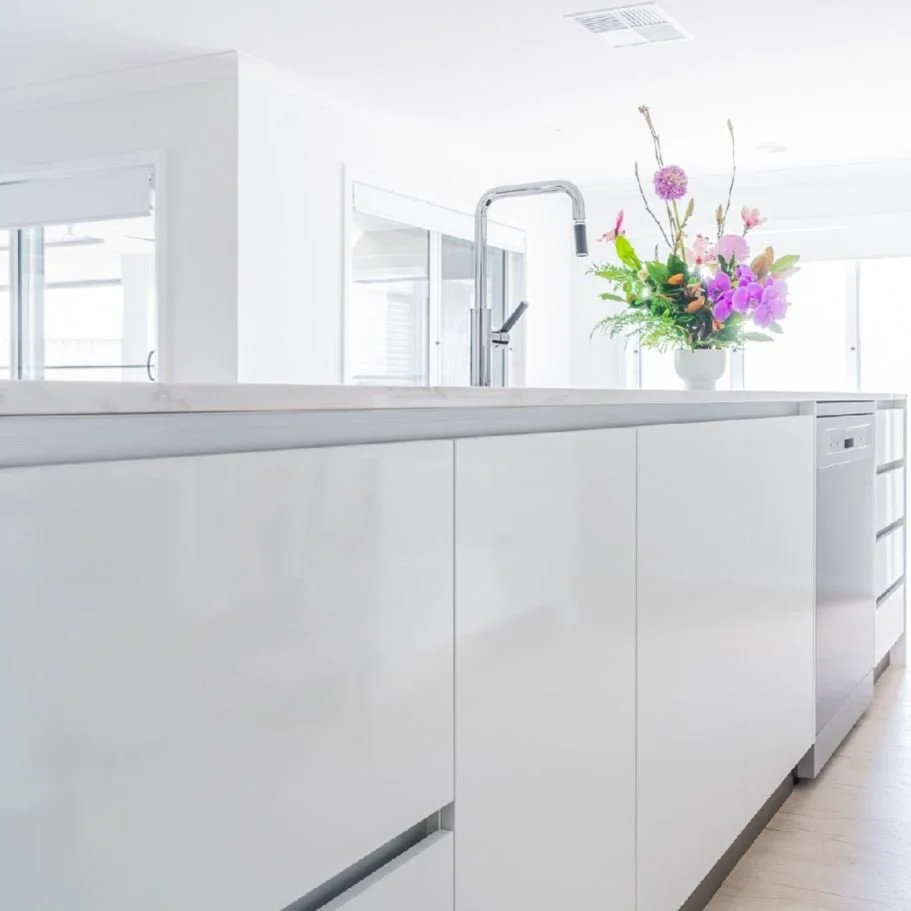Choosing The Best Spot In Your Kitchen For Your Dishwasher
Designing your new home, and deciding where to put your appliances in your joinery designs? Anne Ellard from Houzz Australia, gives you a comprehensive guide to finding the sweet spot for your dishwasher, below.
Although every kitchen layout is different, there are reliable guidelines to help you plan where to place everything. And when it comes to appliances, the placement of the dishwasher is key. Ideally, it should be located somewhere that makes loading and unloading quick and easy – but it also pays to ensure your dishwasher door doesn’t block any work areas or walkways when it’s open.
Place It Next To The Sink
As a kitchen designer, I usually recommend that a dishwasher is positioned next to the sink. There are two reasons for this: the first is that it will make plumbing much easier and less costly, and the second is behavioral. People generally use a ‘scrape, rinse, load’ method to load their dishwasher. This involves scraping leftovers from dishes into the bin (located to one side of, or under, your sink,) then giving dishes a quick rinse under the tap, before loading them straight into the dishwasher. Consequently, the best placement is on the opposite side of the sink to the scraping area.
There are many dishwashers on the market that don’t require dishes to be rinsed before they’re loaded. If you buy one of these, either side of the sink is fine, but do consider whether you want it …
… On The Left Or Right Side
If you decide to position your dishwasher next to your sink, the next consideration should be whether to put it to the left or right. There is no correct answer; however, a right-handed person will hold a dish in their left hand and use their right hand to scrape or wash the dish, therefore making it easier to load dishes into a dishwasher positioned to the left of the sink. The opposite applies to a left-handed person.
Having said that, people are often creatures of habit, so I sometimes find my clients will prefer to locate the dishwasher in their new kitchen on the same side of the sink that it was positioned in their old kitchen, regardless of whether they are left or right handed. The overall layout of the rest of the kitchen and the location of other appliances is also important to consider, so try not to become wedded to left or right at the expense of creating a poor layout in other respects.
Ensure The Dishwasher Is Close To Drawers
Always position the drawer or cupboard where cutlery or crockery is stored, so it’s in close proximity to your dishwasher. This kind of functionality and practicality is essential to any kitchen design. The location of all kitchen appliances in relation to each other, and to the storage in your kitchen, plays an important role in making it a pleasurable place to work in.
Note The Distance To Nearby Cupboards
Aim to have a maximum of one step’s distance between your dishwasher to the cupboard that you are unloading into. Your dishwasher can be adjacent to these cabinets, or opposite them; it doesn’t matter as long as you don’t need to move far between them.
Check Movability Within Your Space
Freedom of movement is an important consideration when designing a layout. This is especially relevant when it comes to the placement of appliances, such as a dishwasher, that open out into the circulation space, and remain open for a period while they are in use.
When planning your kitchen, visualise yourself carrying out daily tasks such as loading and unloading your dishwasher. Try not to position your dishwasher in a location that will block off a main walkway when it’s open. It is also important to consider the location of other appliances, such as a cooktop, in relation to a dishwasher. Avoid having your dishwasher door open into the area in which someone stands when using the cooktop, or the sink for that matter.
Having appliance or cabinet doors clash when they are opened is often unavoidable, particularly in an L- or U-shaped kitchen. However, it is worth ensuring that your cutlery and crockery drawers can be fully opened at the same time as your dishwasher door is open, to make unloading easy.
If Your Dishwasher Is Beneath An Island Bench
In a kitchen with an island bench, you will probably find the island becomes the spot where dirty dishes are dropped as they are cleared away from outdoor entertaining areas, the dining table or the breakfast bar.
For this reason, locating your dishwasher in your island is a very good idea. Dishes can be quickly cleared from the island benchtop, rinsed in the sink if preferred, and then loaded directly into the dishwasher without having to move to another area of the kitchen.
However, it may not always be possible to locate a dishwasher in the centre of a room due to plumbing restrictions, particularly if a home is built on a concrete slab. It is worth speaking with your designer and plumber about this at planning stage as it may be prohibitively expensive.
Consider Integrating Your Dishwasher
If you have an open-plan kitchen, you may be concerned about having a dishwasher that you don’t want seen, particularly if it could be visible from your living area. In this instance, consider an integrated dishwasher; that is, one specially designed to sit behind a panel that matches the rest of your kitchen cabinetry. There are two main types of integrated dishwashers. One is a semi-integrated, as pictured here, where just the top control panel is visible, with the lower part covered by a cabinetry panel.
The other option is a fully integrated dishwasher, as pictured here, giving the illusion that a cupboard or bank of drawers lies behind the cabinet front. In this case, the controls of the dishwasher are located along the top edge of the door, and are only visible when it’s open.
Or Hide It Away In A Walk-In Pantry
Walk-in and butler’s pantries are becoming more popular in kitchens, particularly in new homes. As a kitchen designer, I get regular requests from clients that their dishwasher and a second sink be located in their butler’s pantry. This is so that all dirty dishes can be taken straight there after a meal, and all large pots and pans can be washed there leaving the main kitchen neat and tidy and the sink empty to rinse glasses or wash hands.
Busy families and larger households might consider having two dishwashers, one in the kitchen for everyday ease of use, and one in the butler’s pantry for extra dishes or on those occasions when they have guests over.
Here at Hurst Homes we offer complete customised homes that can be as individual as the owner. We guide your through the entire process including your selections to ensure you create your dream home. Just another reason why we are considered Wagga’s best builder. With over 30 years in the industry as a Wagga Builder you can trust Hurst Homes with your dream home. For information on our upcoming custom Wagga house & land packages, contact us today on 0438 692 962 or fill out the contact us page on our website.
For more tips and tricks from the Houzz experts visit Houzz.com.au

